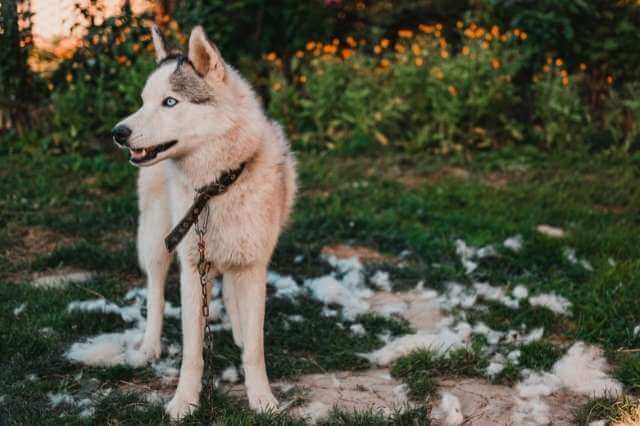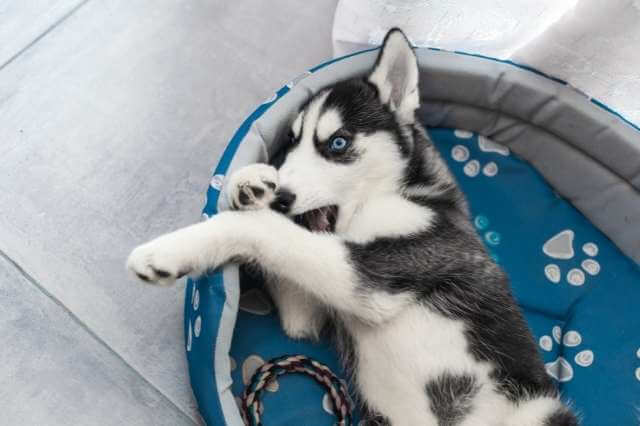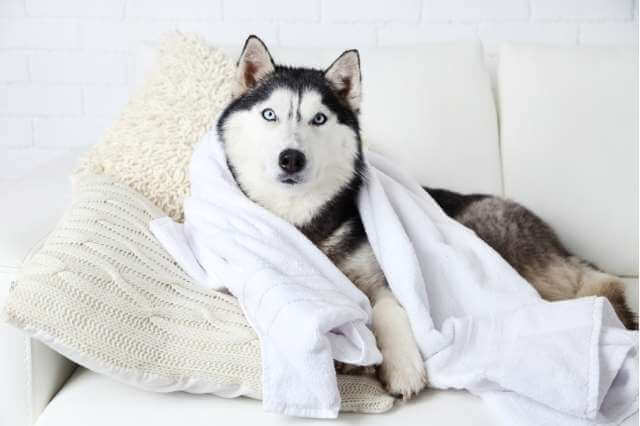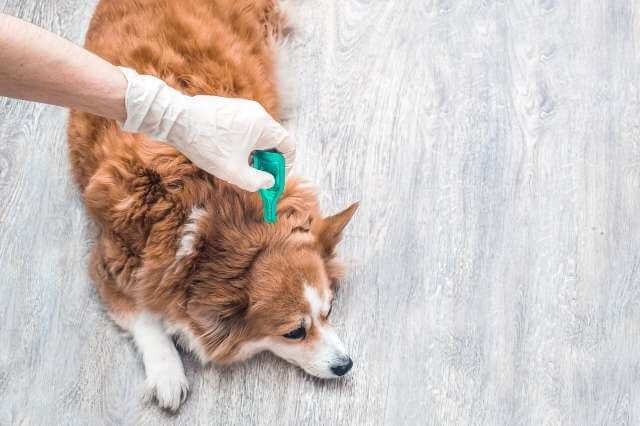Siberian Huskies are renowned for having stunning, thick fur coats, but the severe shedding that comes with that hair is a drawback.
If you’re a dog owner having trouble keeping up with the amount of fur your Siberian sheds, you’re not alone.
Here are some suggestions for reducing Siberian husky shedding.
Keep reading.
Table of Contents
How to Make Huskies Stop Shedding?
Brush your Husky every day, use a de-shedding tool twice weekly, and more frequently when blowing the coat to prevent shedding.
Feed a diet rich in Omega fatty acids that focuses on a coat and healthy skin.
Maintain your Husky’s hydration, bathe him three to four times a year, and keep fleas and parasites under control.
In my view, it’s better to approach your Husky’s shedding from all directions.
For this reason, I’ve put up a list of seven simple strategies for regulating and lowering your Husky’s shedding.

1. Purchase a Brush Designed for Huskies’ Shedding.
Like most dogs, your Husky will shed all year long.
Using a slicker brush often will help stop hair from continuously settling on your furniture, carpet, and clothing, even if you can’t totally avoid it from happening.
Not much work is required to brush him every day, either. 1-2 times a week, depending on your dog may be adequate.
You can acquire a lot of fantastic slicker brushes for your Husky’s topcoat that will take pet dander off of him and keep him looking sharp.
Personally, I have found that the Hertzko Self Cleaning Slicker Brush is the best option to buy on Amazon.
It’s quite easy to use and great for untangling hair.
The bristles are soft, bent wires that efficiently brush the undercoat without causing your pet’s skin irritation.
It is also simple to clean since it features a button that, when pressed, ejects all of the brush’s fur (like the FURminator).
If you brush your Husky’s entire coat many times rather than just once a week, the amount of hair he sheds will be significantly reduced.
2. Purchase a De-shedding Huskies Tool.
A de-shedding tool made primarily for a double coat is the finest item to use while grooming your Siberian Husky.
These gadgets safely remove loose hairs that may otherwise be scattered over your home while catering to your dog’s thick undercoat.
When your best friend is “blowing his coat,” these are perfect to employ.
During the period of excessive shedding, you’ll need to use this equipment a couple of times a week.
I groom my dog’s undercoat with the FURminator device.
It works wonderfully to penetrate your dog’s outer coat and gently remove dead and loose hair without irritating his skin.
I’ve tried a number of de-shedding products over the years, but none have been as successful as the FURminator.

3. Bathe and Groom Your Husky Three to Four Times a Year.
Your Husky will thus change his coat twice a year, in the fall and in the spring, as I already said.
Even while you can’t stop the hair clumps from finally falling out, bathing and combing him during these periods can assist remove more hair at once.
You can remove any remaining fur when bathing time arrives rather than waiting for his undercoat to naturally shed at this period.
Never overbathe since this dries out the skin of your Husky and causes it to lose its natural oils, which promotes further shedding.
The undercoat can be loosened during a bath with specific dog shampoos designed to reduce shedding.
Omega 3 & 6 fatty acid supplements are also included in some, such as the FURminator deShedding Ultra Premium Dog Shampoo.
4. Continue to Hydrate Your Husky.
Allowing your Siberian Husky to drink more water each day will lessen the amount of shedding, even if you might not even be aware of it.
This is due to the fact that dehydrated dogs shed more.
Giving your Husky one ounce of water for every pound of body weight can increase his general health and lessen the quantity of hair that gets all over your house.
I enjoy the concept of a dog water fountain, like the Petsafe Drinkwell, which tempts your dog to drink while saving you the trouble of having to replenish his water on a regular basis.
This one appeals to me since it is a reasonable size, has a nice appearance, and has carbon filters to get rid of unpleasant tastes and aromas from the water.
Pro tip To keep your Husky hydrated in the summer, try offering him ice cubes.
In order to assist your dog stay hydrated, you may give him frozen fruits like strawberries.
These can function as a wholesome substitute for snacks from the shop.

5. Change to a Diet That Focuses on the Skin and Coat.
It’s possible that you’ve already given some attention to what you feed your husky, but did you know that it has a big influence on how often he sheds?
Cheap dog food is typically constructed of components that some dogs find difficult to digest, such as maize and grain, in addition to additional preservatives and additives.
Pick a dog food instead that’s mostly made of high-quality protein.
When it comes to an animal’s nutritional needs, a lack of protein causes its coat to seem untidy and lifeless.
When your Husky is malnourished, the protein he consumes maintains his muscular mass at the expense of his coat.
Do you wish to know more about feeding your dog?
For further details on nutrition, the many sorts of diets for your dog, and exactly what he can and cannot eat, check out our advice on the best diet for Huskies.
Even though it will cost more, it will benefit your Husky by lessening his daily shedding and preserving a long, healthy life.
Your Husky will retain a magnificent, healthy coat if you choose a food that meets his specific nutritional demands, and you may significantly lessen the amount of shedding that occurs all year long.
6. Give Your Husky Omega Fatty Acids in Their Diet.
I’ve already explained how altering your Husky’s food might lessen shedding.
Omega fatty acids can still be added every day to help you shed less all year long.
Omega 3 fatty acid-rich meals can be specifically chosen, or you can give your Husky a daily supplement.
They come in the flavors of salmon, bacon, or chicken and are extremely well-reviewed.
You may also include a small amount of olive oil in your dog’s diet if the food you give him doesn’t have enough fat.
Omega-3 fatty acids included in olive oil benefit the skin and coat, but you should first talk to your veterinarian about dose.
I don’t need to add supplements since the fish oils and vegetable oil (rapeseed) in my dog’s cold-pressed diet keep her skin and coat in excellent shape.
Pro tip When I sometimes top my dog’s dish with tuna or mackerel in oil, I can be sure she will be around if we have salmon!
Long-term shedding will be greatly reduced by including Omega fatty acids in your dog’s food, and your Husky will also be healthier as a result.
7. Continue Your Flea Treatment Regimen.
If your Husky gets fleas, flea medications will stop him from aggressively biting and scratching himself, but they won’t stop him from shedding.
The more fur is dislodged by your dog’s constant scratching to relieve himself from the itching caused by fleas or ticks.
Lack of fleas results in decreased itching and shedding.
Keep up with your Husky’s flea medication, don’t forget.
I give my dog his medication every three months, but you should talk to your physician about what’s best for your dog.

How Can I Get Rid of Husky Hair Around the House?
You have a few options for dealing with the husky hair in your home.
One is to always have a broom and dustpan handy, so you can swiftly sweep up any hair on the floor.
Additionally, you may attempt to routinely brush your dog, which will aid in removing some of the loose hair.
Finally, you may often clean your floors to remove any stray hair. You may assist in keeping your home tidy and dog hair-free by using these suggestions.
What Causes Huskies To Shed So Much?
Some breeds with medium-length, smooth-lying coats shed more than you may expect!
From the interior of your coat pockets to the cabinets of your kitchen, you will discover furry clumps in unexpected locations.
There is husky fur everywhere! But to better understand why Huskies sweat so much, we must take into account his coat.
Due to their dense double coat, huskies shed a lot.
The top coat is wiry, harsh, and waterproof, while the undercoat is made up of a layer of thin, soft hairs that serve as insulation in the winter and cooling in the summer.
As the hair grows normally, it will molt old and damaged hair.
Dogs with a double coat have two layers of fur.
If we take dog coat genetics into account, each hair follicle will have a few undercoat hairs and a few guard (topcoat) hairs.
Puppies are born with a single coat, but about 3 months of age, they start to develop an adult coat, which they maintain until they are around a year old.
The double coat of wolves, the domestic dog’s closest living cousin, is thought to be an ancestral trait.
Due to a hereditary mutation, single-coated breeds do not have an undercoat. Therefore they shed less since the undercoat would molt more frequently as the seasons changed.
When operating as sled dogs in harsh conditions in the past, huskies were dependent on their thick, woolly undercoats to keep them warm.
They were further protected and had an additional layer of waterproofing thanks to their protective coat.
Given their ability to survive a variety of weather situations, Siberian Huskies continue to make outstanding outdoor working dogs.
Similar to the German Shepherd, their topcoat has an oily feel to it.
Final Thoughts
Twice a year, Siberian Huskies lose their undercoats.
This process, known as “blowing the coat,” often takes place in the spring as the temperature warms up and again in the fall to make room for the creation of a new undercoat in preparation for the coming cold winter.
Your Siberian Husky’s undercoat should never be physically removed.
The key to keeping your Siberian Husky clean and happy is routine grooming, not undercoat removal.
Additionally, it’s crucial never to shave a Siberian Husky since the coat acts as a natural insulator against the summer heat and the winter cold, as well as shielding the Husky’s skin from sunburn.
Remember that all huskies need grooming, regardless of whether they are fluffy, long-haired, or short-haired.

